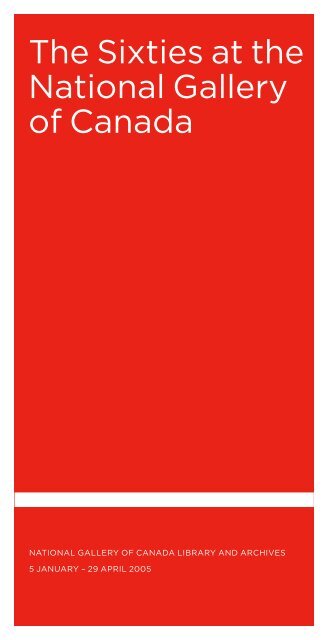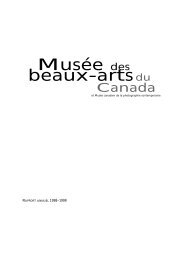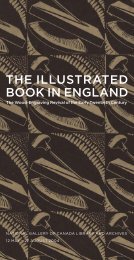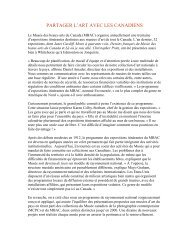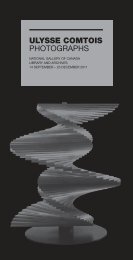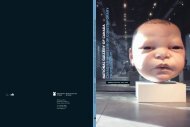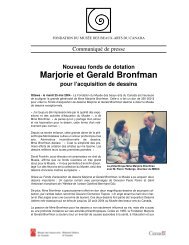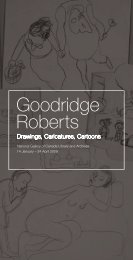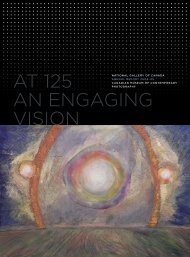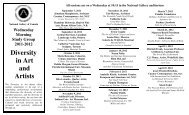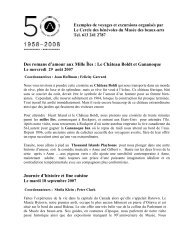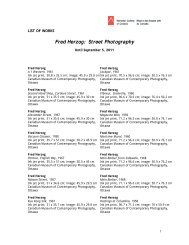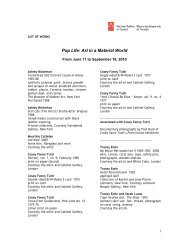The Sixties at the National Gallery of Canada
The Sixties at the National Gallery of Canada
The Sixties at the National Gallery of Canada
Create successful ePaper yourself
Turn your PDF publications into a flip-book with our unique Google optimized e-Paper software.
<strong>The</strong> <strong>Sixties</strong> <strong>at</strong> <strong>the</strong><br />
N<strong>at</strong>ional <strong>Gallery</strong><br />
<strong>of</strong> <strong>Canada</strong><br />
NATIONAL GALLERY OF CANADA LIBRARY AND ARCHIVES<br />
5 JANUARY – 29 APRIL 2005
On February 17, 1960, <strong>the</strong> Right Honourable<br />
John G. Diefenbaker, Prime Minister <strong>of</strong> <strong>Canada</strong>,<br />
<strong>of</strong>ficially reopened <strong>the</strong> N<strong>at</strong>ional <strong>Gallery</strong> <strong>of</strong> <strong>Canada</strong><br />
in <strong>the</strong> newly built Lorne Building on Elgin Street<br />
facing Confeder<strong>at</strong>ion Square (1–3). This new<br />
loc<strong>at</strong>ion would be <strong>the</strong> <strong>Gallery</strong>’s temporary<br />
home until May 21, 1988, when it would move to<br />
its permanent loc<strong>at</strong>ion on Sussex Drive.<br />
<strong>The</strong> <strong>Gallery</strong> also had a new director, Charles Comfort, who had<br />
served as an <strong>of</strong>ficial war artist during World War II and who was, <strong>at</strong> <strong>the</strong><br />
time <strong>of</strong> his appointment, president <strong>of</strong> <strong>the</strong> Royal Canadian Academy <strong>of</strong><br />
Arts and associ<strong>at</strong>e pr<strong>of</strong>essor in <strong>the</strong> Department <strong>of</strong> Art and Archaeology<br />
<strong>at</strong> <strong>the</strong> University <strong>of</strong> Toronto. Comfort’s predecessor, Alan Jarvis, an<br />
outspoken and dynamic director, found himself a victim <strong>of</strong> partisan<br />
politics and had been forced to resign shortly before <strong>the</strong> opening <strong>of</strong><br />
<strong>the</strong> new temporary building. As part <strong>of</strong> his mand<strong>at</strong>e, <strong>the</strong> new director<br />
was expected to re-establish a sense <strong>of</strong> confidence and stability <strong>at</strong><br />
<strong>the</strong> <strong>Gallery</strong> and avoid controversy. Among his early tasks, he had <strong>the</strong><br />
pleasure <strong>of</strong> hosting a visit from Jacqueline Kennedy, who was quickly<br />
becoming an icon <strong>of</strong> <strong>the</strong> early 1960s (5).<br />
Comfort encouraged a series <strong>of</strong> biennial exhibitions <strong>of</strong> Canadian<br />
art th<strong>at</strong> sought to survey contemporary Canadian work. Although artists,<br />
particularly those who lived outside major centres, welcomed <strong>the</strong><br />
opportunity to have <strong>the</strong>ir work shown across <strong>the</strong> country and in one<br />
biennial in England, as well (12), <strong>the</strong> exhibitions proved to be a frustr<strong>at</strong>ing<br />
experience from organiz<strong>at</strong>ional and critical points <strong>of</strong> view. <strong>The</strong> seventh<br />
and last biennial was held in 1968. It did not make a substantial st<strong>at</strong>ement,<br />
nor had any <strong>of</strong> <strong>the</strong> o<strong>the</strong>rs, as too many works were included,<br />
and <strong>the</strong>y were too diverse in style and content. <strong>The</strong> goal <strong>of</strong> a n<strong>at</strong>ional<br />
look was always overridden by distinct regional and linguistic identities.<br />
Consequently, exhibitions presenting regional work, such as Five<br />
Painters from Regina (6), with its distinctive c<strong>at</strong>alogue, were much<br />
more successful.<br />
As Director <strong>of</strong> <strong>the</strong> N<strong>at</strong>ional <strong>Gallery</strong>, Comfort also served as <strong>the</strong><br />
<strong>Canada</strong> Customs arbiter for art, with <strong>the</strong> power to issue certific<strong>at</strong>es<br />
declaring any piece entering <strong>the</strong> country to be a work <strong>of</strong> art and thus<br />
exempt from import duties. In 1965 he deemed Warhol’s Brillo not art but<br />
“merchandise” and <strong>the</strong>refore subject to taxes. Th<strong>at</strong> decision resulted in a<br />
storm <strong>of</strong> neg<strong>at</strong>ive press indicting <strong>the</strong> <strong>Gallery</strong> for its inability to recognize<br />
new boundaries in art. L<strong>at</strong>er th<strong>at</strong> year Comfort retired from his position,<br />
strictly on schedule. Almost forty years l<strong>at</strong>er, Comfort’s actions still<br />
reverber<strong>at</strong>e in <strong>the</strong> art world, <strong>at</strong>tracting <strong>at</strong>tention in <strong>the</strong> press. (10–11)
Jean Su<strong>the</strong>rland Boggs was appointed director on June 1, 1966, under <strong>the</strong> Liberal<br />
Government led by intern<strong>at</strong>ionalist Lester B. Pearson. In addition to being <strong>the</strong> first<br />
director with a doctor<strong>at</strong>e in fine arts, Miss Boggs was also <strong>the</strong> first woman to occupy<br />
<strong>the</strong> position. She quickly established <strong>the</strong> N<strong>at</strong>ional <strong>Gallery</strong>’s visibility and credibility –<br />
n<strong>at</strong>ionally and intern<strong>at</strong>ionally – setting pr<strong>of</strong>essional standards th<strong>at</strong> <strong>the</strong> institution has<br />
striven to maintain ever since (13). Because most <strong>of</strong> her predecessors had come from<br />
Gre<strong>at</strong> Britain, British cultural <strong>at</strong>titudes were reflected in <strong>the</strong> <strong>Gallery</strong>’s management,<br />
programming, and acquisitions. With Miss Boggs’s arrival however, any vestiges <strong>of</strong> a<br />
colonial mentality were soon discarded. Her most dram<strong>at</strong>ic action was to lift <strong>the</strong> ban<br />
on <strong>the</strong> acquisition <strong>of</strong> contemporary American art: Warhol’s Brillo was among <strong>the</strong> first<br />
works purchased. In 1967 she established a permanent collection <strong>of</strong> photography, a<br />
formal recognition <strong>of</strong> <strong>the</strong> photograph as a collectible object.<br />
Miss Boggs’s first year was committed to prepar<strong>at</strong>ions for <strong>Canada</strong>’s forthcoming<br />
centenary. <strong>The</strong> Centennial Lectures, a series sponsored by <strong>the</strong> N<strong>at</strong>ional <strong>Gallery</strong>, fe<strong>at</strong>ured<br />
intern<strong>at</strong>ionally-renowned authorities appearing before audiences across <strong>the</strong> country.<br />
<strong>The</strong> <strong>Gallery</strong> mounted two celebr<strong>at</strong>ory exhibitions. Three Hundred Years <strong>of</strong> Canadian<br />
Art, complete with a birthday cake designed by Greg Curnoe for <strong>the</strong> opening (14),<br />
was <strong>the</strong> first. <strong>The</strong> cake’s decor<strong>at</strong>ive orange and blue icing was flavoured with back<br />
bacon and maple sugar. <strong>The</strong> prepared text declared: “300 Yrs. Of Canadian Art I Think<br />
I Love You! But I Want To Know For Sure! 300 Yrs. Of Canadian Art, Hold Me Tight!<br />
I Need You!” <strong>The</strong> second exhibition, A Pageant <strong>of</strong> <strong>Canada</strong>: <strong>The</strong> European Contribution<br />
to <strong>the</strong> Iconography <strong>of</strong> <strong>Canada</strong>, cur<strong>at</strong>ed by Roy Strong, director <strong>of</strong> <strong>the</strong> N<strong>at</strong>ional<br />
Portrait <strong>Gallery</strong> in London, fe<strong>at</strong>ured a Victorian pavilion interior (15). <strong>The</strong> <strong>Gallery</strong> was<br />
also responsible for preparing Man and His World: Intern<strong>at</strong>ional Fine Arts Exhibition,<br />
Expo ’67, and Sculpture ’67. Sculpture ’67 was installed in front <strong>of</strong> Toronto’s city hall.<br />
<strong>The</strong> formidable K<strong>at</strong>hleen Fenwick, <strong>the</strong> <strong>Gallery</strong>’s first Cur<strong>at</strong>or <strong>of</strong> Prints and Drawings,<br />
retired in 1968 after forty years <strong>of</strong> service (17). Her tenure was celebr<strong>at</strong>ed with an exhibition<br />
<strong>of</strong> drawings <strong>at</strong> Colaghni’s <strong>Gallery</strong> in London, England, <strong>the</strong> Louvre in Paris, and <strong>the</strong> Uffizi<br />
in Florence, marking <strong>the</strong> first occasion th<strong>at</strong> <strong>the</strong> Louvre presented an exhibition from<br />
ano<strong>the</strong>r institution in its Cabinet des dessins. Separ<strong>at</strong>e c<strong>at</strong>alogues were published for<br />
each venue and included an appreci<strong>at</strong>ion written by Jean Boggs in honour <strong>of</strong> Miss<br />
Fenwick’s contribution to <strong>the</strong> <strong>Gallery</strong> and to its collection <strong>of</strong> prints and drawings.<br />
<strong>The</strong> <strong>Gallery</strong> also promoted contemporary Canadian art intern<strong>at</strong>ionally by organizing<br />
exhibitions for biennials and conferences abroad. Smaller in scope with few artists<br />
presented, <strong>the</strong>se exhibitions met with gre<strong>at</strong>er success than did <strong>the</strong> Canadian biennials.<br />
Critics praised Canadian artists who were winning awards or honourable mentions.<br />
Jean-Paul Riopelle landed <strong>the</strong> UNESCO Prize for painting <strong>at</strong> <strong>the</strong> Venice Biennale in<br />
1962 (8). <strong>The</strong> Canadian section won <strong>the</strong> Grand Award for best n<strong>at</strong>ional represent<strong>at</strong>ion,<br />
and Harold Town was awarded <strong>the</strong> second Purchase Prize <strong>at</strong> <strong>the</strong> first Primera Bienal<br />
(1963) Americana de Grabado in Santiago, Chile. At <strong>the</strong> fifth (1967) Paris Biennale,<br />
John Max won an award for his photographs, and in 1968 <strong>at</strong> <strong>the</strong> Venice Biennale,<br />
Guido Molinari won <strong>the</strong> David Bright Prize for painters under 40 (21).<br />
<strong>The</strong> collecting <strong>of</strong> post-war American art, such as paintings by Jackson Pollock<br />
and James Rosenquist, as well as Robert Morris’s Untitled sculpture (a random pile <strong>of</strong><br />
254 pieces <strong>of</strong> felt) and Carl Andre’s Lever (an install<strong>at</strong>ion <strong>of</strong> 137 firebricks), forced <strong>the</strong><br />
<strong>Gallery</strong> to champion and defend <strong>the</strong> work it acquired from innov<strong>at</strong>ive and sometimes<br />
controversial artists (18). An angry public reacted to Morris’s felt piece by throwing<br />
garbage onto it. <strong>The</strong> first exhibition following centennial year was a one-person show,<br />
cur<strong>at</strong>ed by Brydon Smith, <strong>of</strong> <strong>the</strong> American Pop artist James Rosenquist, sometimes<br />
referred to as <strong>the</strong> “Billboard Michelangelo.” <strong>The</strong> artist collabor<strong>at</strong>ed in <strong>the</strong> public<strong>at</strong>ion’s<br />
design and also contributed a text <strong>of</strong> “descriptions <strong>of</strong> experiences” (20). Successive<br />
exhibitions by <strong>the</strong> N.E. Thing Co. (22), Dan Flavin (23), and Greg Curnoe (24), involved
<strong>the</strong> artists with <strong>the</strong> design and content <strong>of</strong> <strong>the</strong>ir c<strong>at</strong>alogues and posters. Flavin designed<br />
a spare black-and-white cover for his c<strong>at</strong>alogue, recalling <strong>the</strong> artist’s fluorescent light<br />
sculptures. He also included writings for <strong>the</strong> c<strong>at</strong>alogue, as did fellow New York artists<br />
Mel Bochner and Donald Judd; Brydon Smith compiled a detailed c<strong>at</strong>alogue <strong>of</strong> Flavin’s<br />
work in <strong>the</strong> exhibition. Greg Curnoe’s c<strong>at</strong>alogue for <strong>the</strong> São Paulo X Bienal consisted<br />
<strong>of</strong> snapshots, taken by <strong>the</strong> cur<strong>at</strong>or Dennis Reid, documenting <strong>the</strong> artist’s daily life: views<br />
<strong>of</strong> his city, his studio, <strong>the</strong> artist <strong>at</strong> work and play, and with his family. <strong>The</strong> cover, designed<br />
by Curnoe, fe<strong>at</strong>ured a boldly coloured rubber-stamped text th<strong>at</strong> simply repe<strong>at</strong>ed <strong>the</strong><br />
title in <strong>the</strong> three languages <strong>of</strong> <strong>the</strong> Bienal. Curnoe, anti-American and an ardent Canadian<br />
regionalist, included six questions <strong>at</strong> <strong>the</strong> end <strong>of</strong> his São Paulo c<strong>at</strong>alogue, <strong>the</strong> sixth<br />
echoing <strong>the</strong> self-doubt with which <strong>the</strong> <strong>Gallery</strong> had struggled in its p<strong>at</strong>riotic efforts in<br />
<strong>the</strong> Canadian biennials: “Can my culture survive <strong>the</strong> constant destruction <strong>of</strong> its parts<br />
in favour <strong>of</strong> a ‘better’ (American, British) culture? Or is th<strong>at</strong> wh<strong>at</strong> my culture is?”<br />
In 1968 <strong>the</strong> N<strong>at</strong>ional <strong>Gallery</strong> <strong>of</strong> <strong>Canada</strong> lost its administr<strong>at</strong>ive autonomy to <strong>the</strong><br />
N<strong>at</strong>ional Museums Corpor<strong>at</strong>ion and ceased to be a separ<strong>at</strong>e legal entity. Instead <strong>of</strong> an<br />
annual report th<strong>at</strong> year, <strong>the</strong> <strong>Gallery</strong> published its First Annual Review (25), fe<strong>at</strong>uring a<br />
detail <strong>of</strong> Michael Snow’s Snow Storm on <strong>the</strong> cover. <strong>The</strong> choice <strong>of</strong> image reflected <strong>the</strong><br />
turbulent <strong>at</strong>mosphere <strong>of</strong> <strong>the</strong> time and illustr<strong>at</strong>ed <strong>the</strong> uncertainty about <strong>the</strong> future facing<br />
<strong>the</strong> institution. For <strong>the</strong> N<strong>at</strong>ional <strong>Gallery</strong> <strong>of</strong> <strong>Canada</strong>, <strong>the</strong> 1960s proved to be not only a<br />
decade <strong>of</strong> transition but also one <strong>of</strong> upheaval.<br />
Peter Trepanier, Head, Reader Services<br />
In memory <strong>of</strong> Mary Hilda Stephens<br />
FURTHER READING<br />
Leclerc, Denise, and Pierre Dessurault. <strong>The</strong> <strong>Sixties</strong> in <strong>Canada</strong>, exhib. c<strong>at</strong>. Ottawa: N<strong>at</strong>ional <strong>Gallery</strong> <strong>of</strong> <strong>Canada</strong>, 2005.<br />
Nemir<strong>of</strong>f, Diana. 3 x 3: Flavin, Andre, Judd, exhib. c<strong>at</strong>. Ottawa: N<strong>at</strong>ional <strong>Gallery</strong> <strong>of</strong> <strong>Canada</strong>, 2003.<br />
Ord, Douglas. <strong>The</strong> N<strong>at</strong>ional <strong>Gallery</strong> <strong>of</strong> <strong>Canada</strong>: Ideas, Art, Architecture. Montreal: McGill-Queen’s University<br />
Press, 2003.<br />
Checklist<br />
1, 2. February 17, 1960. Lorne Building exterior;<br />
Prime Minister and Mrs. John Diefenbaker<br />
arriving <strong>at</strong> <strong>the</strong> N<strong>at</strong>ional <strong>Gallery</strong> for <strong>the</strong><br />
<strong>of</strong>ficial opening. (Photo: Duncan Cameron,<br />
Capital Press Service, Ottawa.)<br />
(two b&w photographs)<br />
“Priv<strong>at</strong>e Visit – In Public,” “Brant Portraits<br />
C<strong>at</strong>ch Jackie’s Eye;” Gordon Dewar,<br />
“3,000 Cheer First Lady,” “At N<strong>at</strong>ional<br />
<strong>Gallery</strong>,” “A Picture <strong>at</strong> <strong>the</strong> <strong>Gallery</strong>.” (nine<br />
newspaper clippings from <strong>the</strong> Ottawa<br />
Journal and <strong>the</strong> Ottawa Citizen)<br />
3. February 1960. Art Reference Library,<br />
third floor. (Photo: Bill Lingard, Photo<br />
Fe<strong>at</strong>ures, Ottawa.) (b&w photograph)<br />
4. February 18 – April 24, 1960. Canadian<br />
Design in Retrospect, 1949–1959.<br />
(Photo: Bill Lingard, Photo Fe<strong>at</strong>ures,<br />
Ottawa.) (exhibition c<strong>at</strong>alogue and<br />
b&w photograph)<br />
5. May 13 – 18, 1961. Janet Lukas, “Noses<br />
Pressed <strong>the</strong> Windows to W<strong>at</strong>ch Jackie<br />
<strong>at</strong> <strong>Gallery</strong>,” “Jackie Enjoys Tour <strong>of</strong> Art<br />
<strong>Gallery</strong>,” “At <strong>the</strong> Art <strong>Gallery</strong>,” “Protocol<br />
Pares Tour <strong>of</strong> <strong>Gallery</strong>;” Starr Cote,<br />
6. November 30 – December 26, 1961.<br />
Five Painters from Regina: Bloore,<br />
Godwin, Lochhead, McKay, Morton.<br />
(exhibition c<strong>at</strong>alogue)<br />
7. December 9, 1981. Gwen Cowley,<br />
“Dress Informal – Two Little Words with<br />
101 Interpret<strong>at</strong>ions. Here Are a Few by<br />
Top Canadian Designers,” <strong>The</strong> (Toronto)<br />
Star Weekly. (newspaper clipping)<br />
8. June 16 – October 8, 1962. Jean-Paul<br />
Riopelle, Paintings and Sculpture:<br />
XXXI Intern<strong>at</strong>ional Biennial <strong>of</strong> Art.<br />
(exhibition c<strong>at</strong>alogue)
9. January 10 – February 3, 1963.<br />
Jean-Paul Riopelle: Painting and<br />
Sculpture. (exhibition c<strong>at</strong>alogue)<br />
10. June, July, August 2004. “Brillo Boxes:<br />
Warhol’s 1968 Brillo Boxes Caused a<br />
Furore in <strong>the</strong> Art World,” Christie’s<br />
Magazine, pp. 34–35. (journal)<br />
11. June 23, 2004. Randy Boswell,<br />
“Art or Merchandise, It’s Yours for $1M:<br />
Customs Ruling on Warhol’s Work<br />
Caused Media Uproar,” Ottawa Citizen.<br />
(newspaper clipping)<br />
12. September 20 – October 27, 1963.<br />
5 th Biennial Exhibition <strong>of</strong> Canadian<br />
Painting 1963. (Photo: Fednews,<br />
Toronto) (exhibition c<strong>at</strong>alogue and<br />
photograph <strong>of</strong> <strong>the</strong> Queen with Charles<br />
Comfort <strong>at</strong> <strong>the</strong> opening, held <strong>at</strong> <strong>the</strong><br />
Commonwealth Institute in London)<br />
13. June 1968. Wendy Michener, “Jean<br />
Boggs: <strong>The</strong> Woman <strong>The</strong>y Didn’t Want,”<br />
Ch<strong>at</strong>elaine, pp. 28–29, 74–75. (Left to<br />
right: Dennis Reid, Mimi Cazort, Brydon<br />
Smith, N<strong>at</strong>han Stolow, Pierre Théberge,<br />
Pamela Osler, Jim Borcoman, Guy Viau,<br />
Jean-Paul Morisset, Bill Bragg, Amos<br />
Paget, Jean Su<strong>the</strong>rland Boggs, Michel<br />
Amyot, André Vigeant, Doro<strong>the</strong>a<br />
Co<strong>at</strong>es.) (magazine article)<br />
14. May 12 – September 17, 1967. Three<br />
Hundred Years <strong>of</strong> Canadian Art: An<br />
Exhibition Arranged in Celebr<strong>at</strong>ion <strong>of</strong><br />
<strong>the</strong> Centenary <strong>of</strong> Confeder<strong>at</strong>ion.<br />
(Photo: John Evans Photography Limited.)<br />
(ten colour Polaroid photographs <strong>of</strong><br />
cake decor<strong>at</strong>ing, fe<strong>at</strong>uring <strong>the</strong> Canadian<br />
artist Greg Curnoe; b&w photograph <strong>of</strong><br />
<strong>the</strong> Secretary <strong>of</strong> St<strong>at</strong>e Judy LaMarsh<br />
cutting <strong>the</strong> cake, flanked by Greg<br />
Curnoe, Pierre Théberge, and Jean<br />
Su<strong>the</strong>rland Boggs; note from Judy<br />
LaMarsh, to Jean Boggs, May 17, 1967)<br />
Painters (and) <strong>the</strong> Mr. and Mrs. H.R.<br />
Jackman Gift <strong>of</strong> <strong>the</strong> Murals from <strong>the</strong> L<strong>at</strong>e<br />
Dr. MacCallum’s Cottage Painted by Some<br />
<strong>of</strong> <strong>the</strong> Members <strong>of</strong> <strong>the</strong> Group <strong>of</strong> Seven.<br />
(Photos: John Evans Photography<br />
Limited, Ottawa.) (two b&w photographs;<br />
left to right: <strong>the</strong> Governor General and<br />
Mrs. Roland Michener, A.Y. Jackson, and<br />
Mr. Henry R. Jackman <strong>at</strong> <strong>the</strong> opening;<br />
install<strong>at</strong>ion view <strong>of</strong> reassembled panels<br />
during exhibition opening)<br />
17. June 16, 1968. K<strong>at</strong>hleen Fenwick with <strong>the</strong><br />
Director, Jean Boggs, on <strong>the</strong> occasion <strong>of</strong><br />
Miss Fenwick’s retirement. (Photo: John<br />
Evans Photography Limited, Ottawa.)<br />
(b&w photograph)<br />
18. December 7, 1968. Gail Dexter, “Brydon<br />
Smith and His Little Collection <strong>of</strong> Artistic<br />
Shockers: <strong>The</strong> N<strong>at</strong>ional <strong>Gallery</strong>’s New<br />
Cur<strong>at</strong>or <strong>of</strong> Contemporary Art Wants to<br />
Shock Us, So He Bought a Felt Sculpture,”<br />
Toronto Star. (newspaper clipping)<br />
19. June 21, 1969. “Here’s a $203,000 Return<br />
on Your Taxes” Weekend Magazine.<br />
(newspaper clipping)<br />
20. January 24 – February 25, 1968. James<br />
Rosenquist. (exhibition c<strong>at</strong>alogue)<br />
21. June 22 – October 20, 1968. Ulysse<br />
Comtois, Guido Molinari: XXXIV<br />
Intern<strong>at</strong>ional Biennial Exhbition <strong>of</strong> Art,<br />
Venice. (exhibition c<strong>at</strong>alogue)<br />
22. June 4 – July 6, 1969. N.E. Thing<br />
Company Limited. (poster)<br />
23. September 13 – October 19, 1969.<br />
Fluorescent Light, Etc. from Dan Flavin.<br />
(exhibition c<strong>at</strong>alogue)<br />
24. September 23, 1969 – January 8, 1970.<br />
Greg Curnoe: <strong>Canada</strong>, X Biennal São<br />
Paulo. (exhibition c<strong>at</strong>alogue)<br />
15. October 27, 1967 – January 19, 1968.<br />
A Pageant <strong>of</strong> <strong>Canada</strong>. (Photo: John Evans<br />
Photography Limited, Ottawa.) (sixteen<br />
b&w photographs <strong>of</strong> Jean Su<strong>the</strong>rland<br />
Boggs with Roy Strong, cur<strong>at</strong>or <strong>of</strong> <strong>the</strong><br />
exhibition; one b&w and three colour<br />
Polaroid photographs <strong>of</strong> install<strong>at</strong>ion<br />
views <strong>of</strong> <strong>the</strong> “Victorian Pavilion”)<br />
16. January 24 – February 23, 1969.<br />
<strong>The</strong> MacCallum Bequest <strong>of</strong> Paintings by<br />
Tom Thomson and O<strong>the</strong>r Canadian<br />
25. 1968–1969. First Annual Review <strong>of</strong> <strong>the</strong><br />
N<strong>at</strong>ional <strong>Gallery</strong> <strong>of</strong> <strong>Canada</strong>, Ottawa.<br />
(journal)<br />
26. October 31, 1969. Prime Minister Pierre<br />
Elliott Trudeau and Margaret Sinclair <strong>at</strong><br />
<strong>the</strong> N<strong>at</strong>ional <strong>Gallery</strong> Associ<strong>at</strong>ion Ball.<br />
(Photo: United Press Intern<strong>at</strong>ional Photo.)<br />
(two b&w photographs)
LIBRARY AND ARCHIVES EXHIBITION NO. 19<br />
19<br />
ISSN 1481-2061<br />
© N<strong>at</strong>ional <strong>Gallery</strong> <strong>of</strong> <strong>Canada</strong>, Ottawa, 2005<br />
PRINTED IN CANADA<br />
380 Sussex Drive, P.O. Box 427, St<strong>at</strong>ion A<br />
Ottawa, Ontario K1N 9N4


